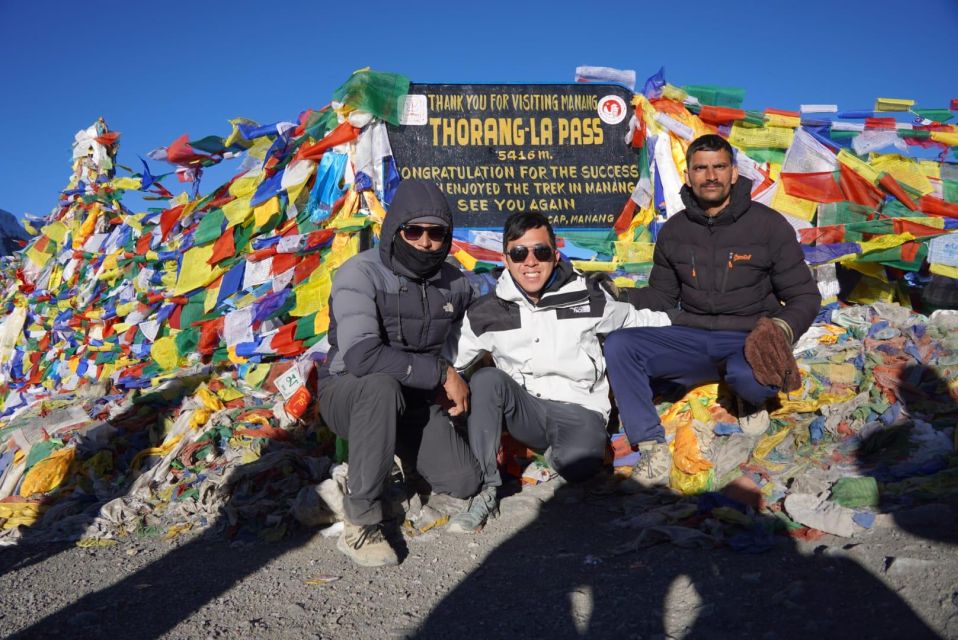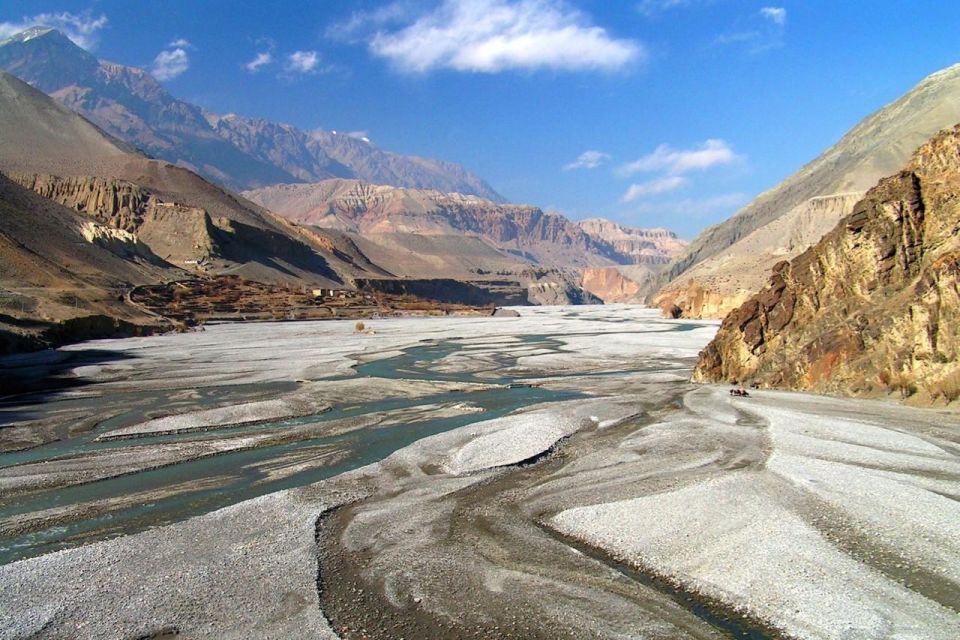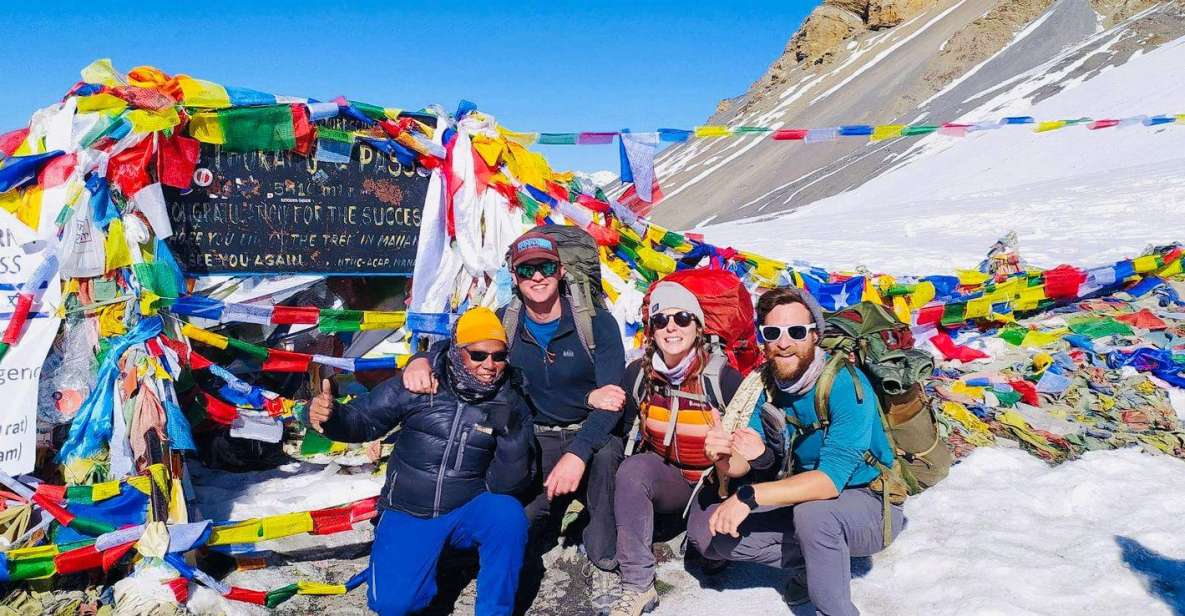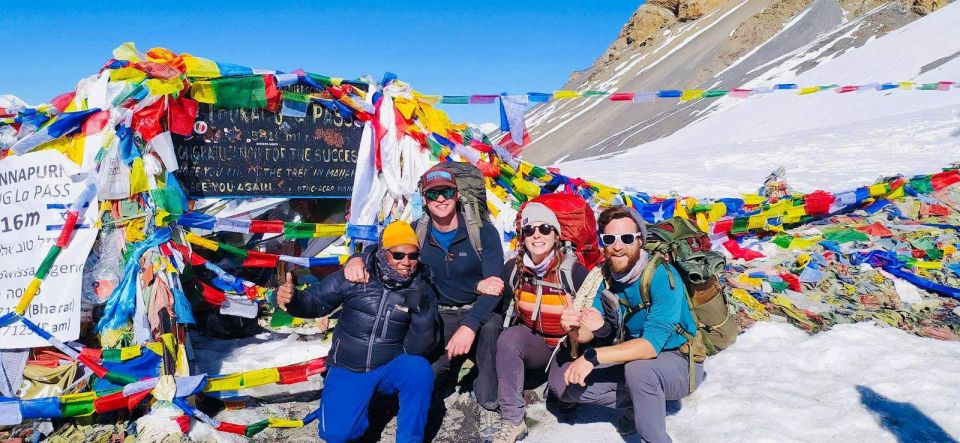The Annapurna Circuit Trek offers an impressive 14-day expedition through Nepal’s breathtaking landscapes, featuring everything from vibrant subtropical forests to stark, high-altitude terrains. Trekkers engage with local cultures, meeting the Gurung and Tibetan communities, while enjoying highlights like ancient monasteries and soothing hot springs. This trek not only presents physical challenges but also rich cultural experiences, making it a comprehensive adventure. However, before planning this journey, it’s crucial to understand what to expect, including essential packing tips and the best times to embark on such an adventure. What else might one need to consider?
Key Points

- The Annapurna Circuit Trek is a 14-day journey through diverse landscapes, including subtropical forests and arid deserts, with iconic views of the Himalayas.
- It features the Thorong La Pass at 5,416 meters, offering breathtaking panoramas and a challenging trek for experienced hikers.
- Cultural immersion includes encounters with Gurung, Manangi, and Tibetan communities, as well as visits to ancient monasteries and local festivals.
- The trek provides essential services such as accommodation, meals, a guide, and porters, ensuring a comfortable experience without logistical concerns.
- Optimal trekking seasons are spring (March to May) and autumn (September to November), providing mild temperatures and stunning mountain views.
It's also worth checking out some other tours and experiences nearby.
Overview of the Trek

The Annapurna Circuit Trek offers adventurers a thrilling 14-day journey through breathtaking landscapes, cultural richness, and the challenge of crossing the iconic Thorong La Pass at 5,416 meters.
This trek showcases diverse environments, from lush subtropical forests to stark mountain deserts, allowing trekkers to enjoy nature’s beauty.
Travelers can expect to experience vibrant local cultures, including the Gurung, Manangi, and Tibetan communities, enriching their journey with authentic interactions.
With a starting price of $1,544.68 per person, the trek includes essential amenities like accommodation, meals, and guided support.
Plus, with flexible booking options like free cancellation and reserve now, pay later, it’s designed to accommodate various adventurers while ensuring a memorable experience.
Trekking Experience Highlights

As trekkers journey through the Annapurna Circuit, they encounter a stunning array of diverse landscapes and vibrant cultures that enrich their adventure.
From subtropical forests to alpine meadows and arid deserts, the trek offers breathtaking views at every turn.
Along the way, trekkers meet welcoming Gurung, Manangi, Thakali, and Tibetan communities, providing a unique cultural experience.
They can explore ancient monasteries, gaining insight into the region’s spiritual heritage.
The trek also includes a relaxing stop at the natural hot springs in Tatopani, where weary muscles rejuvenate.
Each day unfolds new sights and experiences, making the Annapurna Circuit not just a trek but a journey through nature and culture that leaves lasting memories.
Detailed Itinerary

Embarking on the Annapurna Circuit Trek takes adventurers through a meticulously planned 14-day itinerary, each day offering unique challenges and stunning scenery to experience. The journey begins in Kathmandu, where trekkers acclimatize before driving to Dharapani.
Daily treks lead them through picturesque villages, including Chame and Manang, allowing immersion in local culture. Day six focuses on acclimatization, essential for the ascent to Thorong La Pass on day nine.
Trekkers descend to Muktinath, then either trek or drive to Tatopani for a relaxing soak in hot springs. Days eleven and twelve feature the scenic hike to Ghorepani and the iconic sunrise view from Poon Hill.
The adventure concludes with a bus ride back to Kathmandu, wrapping up an unforgettable experience.
What’s Included in the Package
Included in the Annapurna Circuit Trek package are essential services that ensure a comfortable and memorable experience for adventurers. Participants can expect a well-rounded support system, making their trek enjoyable and hassle-free. Here’s what’s included:
-
Accommodation and Meals: Two nights in a 3-star hotel in Kathmandu, plus full board meals during the trek (breakfast, lunch, and dinner).
-
Transportation: Private car for airport/hotel transfers and local transportation between Kathmandu and Syange, as well as Pokhara to Kathmandu.
-
Guidance and Support: An experienced guide, porter or Sherpa for luggage, trekking map, insurance, and necessary permits.
These inclusions allow trekkers to focus on the stunning landscapes and cultural experiences throughout their journey.
Exclusions to Consider
Personal expenses can add up during the Annapurna Circuit Trek, so trekkers should plan for items not covered in the package. While the trek includes many essentials, costs for personal items can quickly accumulate.
Trekkers need to account for travel insurance, which is crucial for safety. Tips for guides, porters, and drivers are expected and should be budgeted accordingly.
Plus, beverages—whether hot, cold, or alcoholic—aren’t included, so daily hydration and enjoyment should be factored in. Personal shopping and laundry services can also add unexpected expenses.
Lastly, trekkers must provide their own trekking equipment, like boots and sleeping bags, which can vary significantly in cost. Preparing for these exclusions ensures a smoother trekking experience.
Best Time to Trek
The best time to trek the Annapurna Circuit is during the spring (March to May) and autumn (September to November) seasons, when the weather is generally stable and the stunning views are unobscured by clouds. During these periods, trekkers can enjoy the vibrant landscapes and diverse flora that enhance the experience.
Here are three reasons to consider these seasons:
-
Optimal Weather: Mild temperatures and minimal rainfall create favorable trekking conditions.
-
Clear Views: Unobstructed vistas of the majestic mountains make for breathtaking photography opportunities.
-
Cultural Events: Spring and autumn host various local festivals, offering unique cultural insights for trekkers.
Choosing the right time can significantly enhance the overall trekking experience on the Annapurna Circuit.
Essential Packing List
Packing for the Annapurna Circuit Trek requires careful consideration to ensure trekkers are well-prepared for varying weather conditions and rugged terrains.
Essential items include a sturdy pair of trekking boots, moisture-wicking clothing, and a waterproof jacket to protect against rain and snow.
Trekkers should also pack a warm sleeping bag rated for low temperatures, a reliable backpack, and trekking poles for stability on steep paths.
Don’t forget a first-aid kit, water purification tablets, and high-energy snacks to maintain energy levels.
Plus, essential gear includes a sun hat, sunglasses, and sunscreen to guard against UV exposure at high altitudes.
Lastly, a good-quality map and a power bank for charging devices will enhance the trekking experience.
Local Cultural Insights
Exploring the Annapurna Circuit offers trekkers a unique opportunity to enjoy the rich tapestry of local cultures, where vibrant traditions and customs thrive in the backdrop of stunning landscapes.
Travelers encounter diverse communities, each with its distinct heritage. Here are three cultural highlights to engage with:
-
Traditional Festivals: Witness colorful celebrations such as Dashain and Tihar, showcasing local beliefs and customs.
-
Culinary Delights: Taste authentic dishes like Dal Bhat and momos, reflecting the region’s agricultural bounty and culinary skills.
-
Monastery Visits: Explore ancient monasteries, where monks practice age-old rituals and share insights into their spiritual lives.
These experiences not only enrich the trekking journey but also foster a deeper appreciation for the region’s cultural legacy.
Here's a few more nearby tours and experiences we think you'll like.
Frequently Asked Questions
What Fitness Level Is Required for the Annapurna Circuit Trek?
For challenging treks, a moderate fitness level’s essential. Participants should build stamina through regular hiking and cardio exercises. Gradual acclimatization also helps, ensuring they enjoy the experience while managing altitude and physical demands effectively.
Are There Any Age Restrictions for Participants?
Participants usually don’t face strict age restrictions, but organizers recommend that trekkers be at least 12 years old. They encourage younger trekkers to be accompanied by an adult for safety and support throughout the journey.
How Does Altitude Sickness Affect Trekkers?
Altitude sickness can cause headaches, nausea, and fatigue among trekkers. It occurs when the body struggles to adapt to reduced oxygen levels at high elevations. Proper acclimatization and hydration can help mitigate these symptoms effectively.
Is Wi-Fi Available During the Trek?
During the trek, Wi-Fi’s often limited, especially in remote areas. Most teahouses provide access, but it’s unreliable. Trekkers should prepare for occasional disconnections and consider offline options for navigation and communication needs.
Can I Trek Solo or Do I Need a Guide?
Many trekkers prefer hiring a guide for safety and navigation, as solo trekking can pose challenges. However, experienced adventurers might trek alone, but it’s essential to be well-prepared and informed about local regulations.
Not for you? Here's more of our most recent tour reviews happening neaby
- Kathmandu: 10 Day Annapurna Base Camp Trek
- From Kathmandu: 13 Day Poon Hill & Annapurna Base Camp Trek
- Casino Tour in Kathmandu
- Langtang Valley Trek – 10 Days
- From Kathmandu: 15 Day Everest Base Camp Trek & Gokyo Lake
- Everest High Pass Trek – Nepal
- Kathmandu: Everest Base Camp Kala Patthar 15-Day Trek
- Langtang Valley Trek – 7 Days
- Annapurna Base Camp Trek
- From Tribhuvan: Manaslu Circuit 14-Day Guided Hiking Tour
- From Kathmandu: 12 Days Everest Base Camp Guided Trek
- Everest Photo Expedition: 14-Day Trek for Photographers
- Top of the World – Nepal – 12 Days Everest Base Camp Trek
- Nepal Spiritual Laughing 14 Day Trekking Program
- Everest Base Camp Helicopter Shared Tour
Recap
The Annapurna Circuit Trek offers an unforgettable adventure through breathtaking landscapes and vibrant cultures.
Trekkers won’t only challenge themselves physically but also enrich their souls by connecting with local communities and experiencing their traditions.
With careful planning, including the right gear and timing, anyone can embark on this remarkable journey.
Ultimately, the trek promises to leave lasting memories, inspiring a deeper appreciation for the majestic beauty and diversity of Nepal’s Himalayas.
